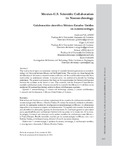
Please use this identifier to cite or link to this item:
http://ricaxcan.uaz.edu.mx/jspui/handle/20.500.11845/196Full metadata record
| DC Field | Value | Language |
|---|---|---|
| dc.contributor.other | 0000-0002-7441-3233 | |
| dc.contributor.other | 0000-0002-3670-8356 | |
| dc.coverage.spatial | México-Estados Unidos | es_ES |
| dc.creator | Foladori, Guillermo | |
| dc.creator | Záyago Lau, Edgar | |
| dc.creator | Appelbaum, Richard | |
| dc.creator | Parker, Rachel | |
| dc.date.accessioned | 2017-04-28T18:15:15Z | |
| dc.date.available | 2017-04-28T18:15:15Z | |
| dc.date.issued | 2012-06 | |
| dc.identifier | info:eu-repo/semantics/publishedVersion | |
| dc.identifier.issn | 0187-7372 | es_ES |
| dc.identifier.uri | http://hdl.handle.net/20.500.11845/196 | |
| dc.description | This work is based upon an exploratory analysis of scientific bilateral agreements on nanotechnology (NT) that exist between Mexico and the United States. The analysis was done through the identification of the main NT research centers in Mexico and the available information they have made public via institutional websites. A second survey was performed to identify key funding institutions. The general conclusion is that there are few opportunities for bilateral collaboration between the countries in the broad NT area. This contrasts with the European Union–Mexico scientific collaboration policy. It seems reasonable to conclude that Mexican NT will likely see its traditional US partnerships decline, relative to those with European countries. | es_ES |
| dc.description.abstract | Este trabajo está basado en un análisis exploratorio de los acuerdos de colaboración científica en nanotecnología entre México y Estados Unidos. El análisis fue realizado mediante la identificación de los principales centros de investigación en nanotecnología en México y la información disponible en las respectivas páginas web institucionales. Un segundo relevamiento fue realizado para identificar las principales agencias de financiamiento. La conclusión general es que existen pocas oportunidades para colaboración bilateral entre los países en la amplia área de las nanotecnologías. Contrasta esta situación con la política científica de colaboración entre México y la Unión Europea. Resulta razonable concluir que las nanotecnologías en México van a ver a Estados Unidos, su tradicional socio, declinar a favor de los países europeos. | es_ES |
| dc.language.iso | eng | es_ES |
| dc.publisher | El Colegio de la Frontera Norte | es_ES |
| dc.relation | https://ojs.colef.mx/index.php/fronteranorte/article/view/805 | es_ES |
| dc.relation.uri | generalPublic | es_ES |
| dc.rights | Attribution-NonCommercial-ShareAlike 3.0 United States | * |
| dc.rights.uri | http://creativecommons.org/licenses/by-nc-sa/3.0/us/ | * |
| dc.source | Frontera Norte Vol. 24, núm. 48, julio-diciembre, pp. 145-164. | es_ES |
| dc.subject | info:eu-repo/classification/Nanotechnology | es_ES |
| dc.subject | info:eu-repo/classification/Science and technology policies | es_ES |
| dc.subject | info:eu-repo/classification/Science collaboration | es_ES |
| dc.subject | info:eu-repo/classification/Research and development | es_ES |
| dc.subject | info:eu-repo/classification/Nanotecnología | es_ES |
| dc.subject | info:eu-repo/classification/Ciencia y tecnología - Políticas | es_ES |
| dc.subject | info:eu-repo/classification/Colaboración científica | es_ES |
| dc.subject | info:eu-repo/classification/Investigación y desarrollo | es_ES |
| dc.subject.classification | INGENIERIA Y TECNOLOGIA [7] | es_ES |
| dc.title | Mexico–U.S. Scientific Collaboration in Nanotechnology | es_ES |
| dc.type | info:eu-repo/semantics/article | es_ES |
| Appears in Collections: | *Documentos Académicos*-- UA Estudios del Desarrollo | |
Files in This Item:
| File | Description | Size | Format | |
|---|---|---|---|---|
| Foladori, Zayago. US Mexico.pdf | Versión publicada | 363,69 kB | Adobe PDF |  View/Open |
This item is licensed under a Creative Commons License
